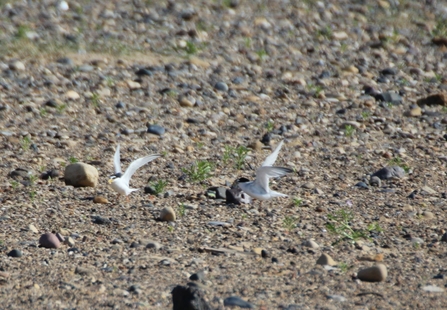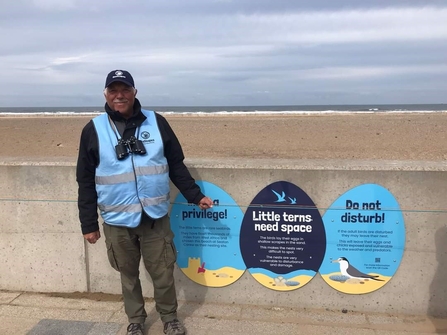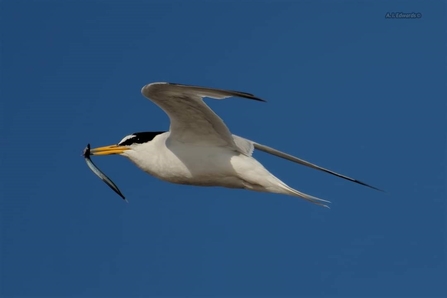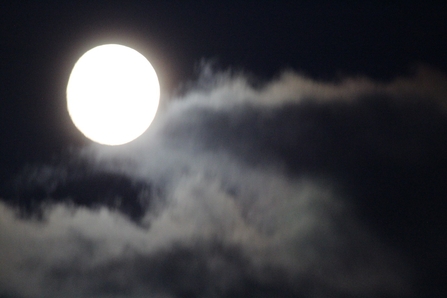Here you will find regular updates about the progress of our fabulous little terns and all of the interesting activity in and around the protected nest site at Seaton Carew. This year we will also devote our attention to the progress of our local ringed plovers who share the site with the little terns, although in much smaller numbers. Features will be contributed by our amazing volunteers: Tony, Mike, Keith and Dawn and also by Durham Wildlife Trust wardens: Alex, Dobrawa, Shona and myself…..Derek.
Returning Terns
Little terns (c) Mandy Bell

The Seaton Carew little tern site is one of a number of SeaScape projects spanning the Tyne to Tees coastline which has been carried forward following the successes of 2022 and continues to be funded in part via the National Lottery Heritage Fund. The investment and planning which has gone into this project is clear to anyone who has visited the site and we have received overwhelming support and appreciation from the general public. If, after reading this, you would like to know more or even visit the site we will be delighted to see you there…..you may even be motivated to join our team of volunteers. You’ll find us on the promenade, conveniently adjacent to the Seaton Beach car and coach park – TS25 1DD in your sat nav.
The little terns have already begun to arrive from their home in West Africa and their numbers have grown steadily to reach our highest count of 62 birds thus far this year. At this early stage in the breeding cycle, visitors to the site might be fortunate enough to observe the birds performing their courtship routines involving parallel flying and tempting partners with tasty sand eels. Their amazing aerobatics is something to behold.
Looking ahead, in two or three weeks we expect to see the adult little terns and ringed plovers settling into the scrapes they use as nests and incubating their eggs. We will keep you updated via future blogs but for now I’d like to share a piece written by Tony – our stalwart volunteer who devotes so much time and energy to the wellbeing of our precious visitors…...

One of the stars of the volunteer show (c) Explore SeaScapes
Reproduced with kind permission of Tony
The little tern is our smallest seabird, only 5 inches long and with a 10 inch wingspan. They sit upright with a distinctive grey coat, white body with a black cap, orange bill and legs. Due to environmental pressures on these little birds, they are currently classed as seriously endangered and registered on the Amber list. The entire UK population during the summer months is recorded by the RSPB only some 1450 pairs so we were privileged to welcome circa 140 individuals to our Seaton Carew colony in last summer.
Things the public often want to know:
Where do they come from?
Little terns fly some 4000km from The Gambia in West Africa to breed on our beach. The journey takes them three months, much of it beach hopping in a fly-feed-rest cycle but the long in-flight stretches they must achieve are clear, including for example Morocco to Spain or the English Channel. They have even been spotted in the Canaries. These little birds must contend with prevailing winds, finding food and places to rest up. Of course, their actual route is largely speculative although it is based on the recorded sightings of ringed little terns around Europe. Last year, 69 of the Seaton Carew fledglings were ringed by Chris, our licensed bird ringer, and we look forward to some of our previous birds returning.
Why our beach?
It’s ideal terrain for them. They need loose cobble which offers a degree of camouflage for their eggs and also the visibility and cover to protect themselves against predators. Our sand is well drained and does not dry hard or clog whilst the long, shallow sedimentary beach provides a large area for the birds to feed, mainly at low tide.
How do they know about the enclosure?
Migratory birds become ‘hard wired’ in their DNA in order to make accurate repeat journeys. The young learn from their flock of elders too. Remarkably, less than a handful of birds each year miss the site and nest on the beach nearby. There’s always one!
Any little tern which arrives this year will be two years old or more as last year’s fledglings spend their first year in The Gambia, maturing and gathering strength for the trip. They can live up to 20 years after all.
When do the arrive and leave?
The begin to arrive at the very end of April and early May but can be delayed by inclement weather. They don’t travel in one large flock but accumulate in smaller daily additions until we have our full population by late May. Last year we had 140 adult birds, 49 active nests and a wonderful 89 chicks.
Some birds arrive in their pairs as they can mate for life whereas others pair up during the flight or on arrival at the site. Once on the site they begin to establish themselves, selecting the best position for their scrape where they will lay a clutch of between one and three eggs. They have neither time nor resources to build an actual nest, instead they quickly make a scrape deep enough to lay amongst the sand and stones. Little terns can become quite territorial and prefer a patch of about one square metre and will even shoo off roaming chicks from their patch.
Courtship behaviour is very particular to the little tern, involving pairs displaying mirror flying, often at a great height. The mate will impress the female with a silver fish which he has caught, sometimes feeding her on the wing.

They usually begin laying in the first week of June and chicks appear some 18 to 20 days later. Inside three days they will be exploring near the scrape and in three weeks going to the shore learning to feed. Their main diet is sand eels but they fish for small mackerel, herring and soft crustaceans. Both birds are excellent parents, both fishing for food to feed the chicks and brooding them under their wings.
What threats do they face?
Unfortunately it is nature and all creatures have their threats. Crows and gulls will take eggs and small chicks if they can. We have also had a kestrel and an owl checking out the site but we never witnessed them taking a tern or a chick. To be positive, terns are extremely protective as a community and you may be lucky to see every tern rising up en-masse to see off some gulls foolish enough to venture too close.
We also have foxes nearby on our dunes and they pose a real threat to eggs and chicks. Indeed, last year, before we had time to react to their presence, foxes had taken about 27 nests. At considerable expense of their own time, some wardens successfully mounted overnight cover to deter the foxes using only torch light and harmless laser pens. Last year’s fox incursion happened early in the season and we are confident the affected terns laid for a second time.

That’s not all of course. You will read, hear and observe much more as well – and be sure to tell the rest of us! There is no better way to learn about these fascinating little creatures than by watching them. Every time you will note something new and maybe something no one else has ever seen.
Have fun!

Support us
By becoming a member you can help us continue our vital work for wildlife

